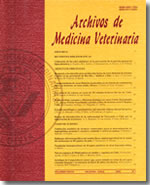Determination of sulphur contents in water, forage and ruminal hydrogen sulphide concentrations in beef cattle herds from La Araucanía, Los Ríos y Los Lagos regions of Chile.
Main Article Content
Abstract
Sulphur is an essential element for the metabolism of ruminant animals. However, high dietary concentrations of sulphur are potentially harmful. The purpose of this study was to measure the forage and water sulphur content in samples from 45 beef herds from the La Araucanía, Los Ríos y Los Lagos regions of Chile. Additionally, ruminal gas hydrogen sulphide (H2S) concentrations were obtained from 5 animals on each farm. Samples were collected during the spring 2008 and summer 2009. Pasture sulphur content was 1,482 ± 592 ppm in the spring and 1,471 ± 448 ppm in the summer. Water sulphur concentrations in all farms was < 1.5 ppm each season. Ruminal gas H2S concentrations in animals was 273 ± 187.5 ppm and 245.4 ± 173 ppm in spring and summer, respectively. Positive and significant correlations were found between pasture sulphur content and ruminal H2S concentration for both periods. Estimated total sulphur intake considering pastures and water was < 0.2% sulfur on a dry matter basis. The results of this study suggest that forage and water sulphur concentrations in Southern Chile do not represent a potential risk of intoxication in grazing beef cattle.

